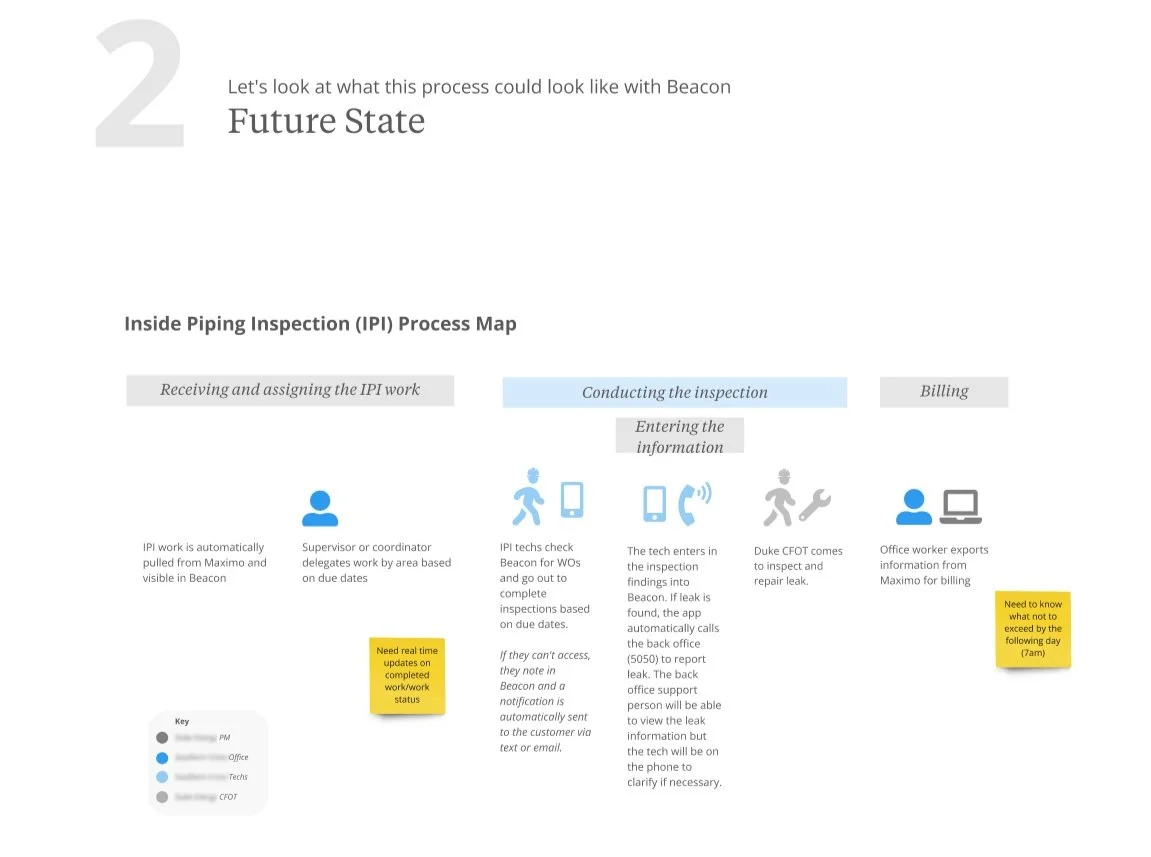Midwest Field Compliance Work
Streamlining technician processes while aligning a natural gas business
Client
A US Natural Gas business
Discovery Phase
Spring/Summer 2024
Team
Discovery research and strategy lead by Cassandra Cortez Gerardo in collaboration with a product owner from the Natural Gas company.
Background
As part of a larger initiative called Digital Worker, my role was to help find a replacement to an outdated digital tool used by a 1/3 of the business in the Midwest. Upon research, I realized the needs of the various users across the Midwest required more specialized tools than what the existing digital product had to offer. I then began a deep dive into each user group to determine opportunity areas.
Slide from deck illustrating to stakeholders how we reframed the initial business problem to be more user-centric.
Part of the strategy was to determine what existing tools used by the other 2/3 of the business could be utilized and uplifted to fit the Midwest’s needs, and what might we need to build from scratch that could also be beneficial to the rest of the business.
Slide demonstrating to stakeholders the tactics we’d take in our overall Digital Worker strategy.
Challenges
The business put the larger Digital Worker Initiative on hold indefinitely. At this point however, my team realized we had done so much research and uncovered so many potential opportunities to add value to the business, that we decided to continue with individual business cases in order to show desire, viability, and feasibility of our discovery.
Process + Deliverables
A Refined Scope
The particular business problem we were now facing centered around the Midwest natural gas technicians relying on a paper-based system to record inspection information due to the lack of mobile digital solutions. Their process necessitated manual transcription of data into the existing digital product by either the technician or a data entry lead, leading to transcription errors and duplicate work.
How might we provide midwest technicians with a mobile digital solution that streamlines the recording and reporting of compliance short-cycle inspections so that we can eliminate data entry redundancy, reduce transcription errors, improve efficiency, ensure consistent data capture for audits, and align five-state compliance digital applications?
Breakdown of participant demographics for the narrowed business case.
Multiple interviews took place to better understand the various differences in field compliance work in the Midwest versus the rest of the business. An additional challenge was the unique types of compliance work required in this territory versus the others. We scoured policies and procedures documents to understand what was truly required by the business and each relevant state to ensure the technicians were doing the required work in the most efficient way.
Screenshot of some interview notes.
User Journey Workshop
After understanding users painpoints and needs, we conducted in-person workshops with the affected groups to validate current state and envision an ideal future state. We also captured any fears, dependencies, and risks associated with these changes.
The business already had a tool that would meet the needs of the Midwest users. We were initially going to keep the workshop product agnostic, but realized that in the limited workshop time we had, we wouldn’t get concrete feedback to move forward. We decided to test the assumption of future state existing in the other digital tool called Beacon that was available and used by the rest of the business for compliance work.
Screenshot of Miro board from workshop depicting current process and desired future state.
Example of current state map.
Example of future state map.
Participants were excited about moving work into Beacon, so not only did the workshop help map future state, but also strengthened user and leadership buy-in.
Low-fi Prototyping
By making this assumption to move compliance work within Beacon, we were able to quickly validate desire and begin immediately paper prototyping and testing with users.
Overview of various rounds of prototypes for different types of compliance work.
Example of a prototype version with feedback.
Determining Feasibility and Viability
We also worked with the devolopment team to determine where data needed to be pulled from as well as resources and timing needed to complete the work required.
Example of data mapping during a dev workshop.
In addition to aligning compliance work across a single application, we were able to not only recoup ~$438K per year in capacity savings, but we were able to also identify compliance work that was no longer required. Between capacity savings, and cost avoidance of building out an additional compliance flow, we captured $1.5M in savings annually by migrating compliance work into Beacon.
Below is the business case I presented to leadership that demonstrates operational waste, user and business opportunities, and the technical proposal.










